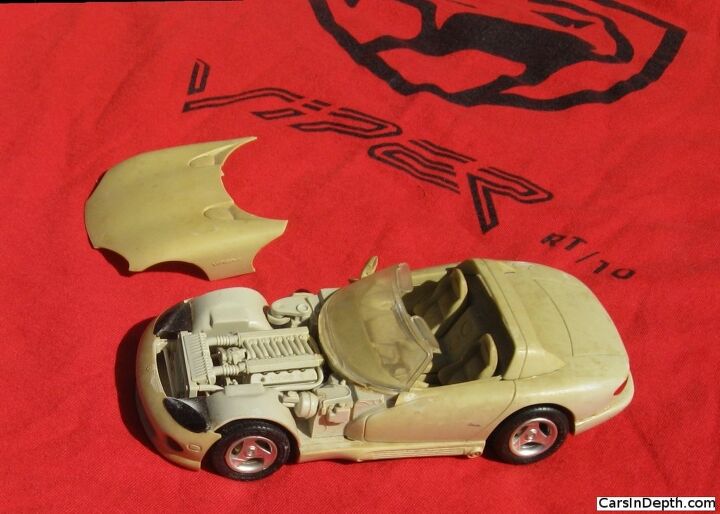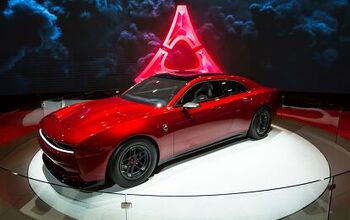Dad, Is This How Vipers Really Go Together?

The longer I do this, the more I realize that it’s about people, not machines. Don’t get me wrong, I still think that cars are way cool, something only human beings could create, but it’s those human beings involved in that creation that make stories worth telling and hearing. When my son, my only son, Moshe, whom I love, was a boy we put model cars together. It was a father-son thing but I also wanted him to learn a little patience. We took care putting them together, but we rarely painted them. That too took much patience. Sometime when he was in fifth grade, so this would have been 1994 or 1995 when Mo was ten years old, we were building a model of a Dodge Viper. It was an AMT/Ertl kit, in 1:25 scale.
I let him pick out the models that we built and by the time he picked out a Viper, we’d already assembled a Lamborghini Diablo and a Ferrari Testarossa and by then we might have made his Pinewood Derby racer too (the fastest finisher that wasn’t over the legal weight limit). While building the Viper, though, he asked me a question about the Viper kit that he hadn’t asked about the other models. “Abba,” he said, “is this how Vipers really go together?” I told him that it was a pretty detailed and accurate model, but no, they didn’t go together quite the same way as the model kit. Then I said to him, “Well, the factory where they build them is on Conner in Detroit. The president of Chrysler is a man named Robert Lutz. I’ll get you the address of the Chrysler headquarters in Highland Park (this was before the move to Auburn Hills), and you can write him a letter about visiting the factory with your classmates from school.”
I got the address and Mo wrote the letter. He composed it himself (with some guidance) and wrote it in his best penmanship, which by the time he was 10 had devolved to a bit of a scrawl. He even addressed the envelope himself. I didn’t really think anything would come of it, but Mo’s grandfather always told me that it never hurts to ask, the worst that can happen is that someone will say no. A couple of weeks later Moshe’s mom called me at work and told me that someone from Chrysler was trying to get in touch with me. We had a ’91 Dodge AWD minivan that we liked a lot but it also went through four of those 604 transmissions while we owned it, mostly at Chrysler’s expense. I figured it was something to do with our Caravan so I called the number.
The gentleman identified himself as the general manager of manufacturing for the Chrysler corporation. I’ve lived around Detroit my whole life, I was working for DuPont Automotive at the time, one of the few companies that was a Tier One, Tier Two and Tier Three supplier to the auto industry, and I knew right away that people at that high level don’t call up folks about their bad transmissions.
“I have a letter here that your son apparently wrote. I want you to know that it’s gotten more attention here than a letter from President Clinton would have. Honestly, if an adult had written it, it would have gone into the circular file, but Mr. Lutz liked how your son wrote it himself and we’d like to invite his class for a field trip to see how Vipers are really built at the Conner Ave plant.”
I told him that the school had two fifth grades, so we’d be talking about fifty 10 year olds, not twenty five, plus adult chaperones. He said that would be no problem. This was one school field trip for which finding enough adult supervision was also going to be no problem at all. He laid out the proposed itinerary, a VIP tour of the plant and assembly line, a question and answer period with some snacks, and maybe some gifts. I explained that it was a Jewish parochial school and that Detroit favorites Faygo pop and Better Made potato chips were kosher.
The tour went off without a hitch. The factory workers, handpicked from Chrysler’s employees at large, were thrilled to see kids come through the plant. The last thing they do before hanging the body panels is test the rolling chassis on a dynamometer. Large concrete pillars rose up, hydraulically, from the floor to keep the car in place should it manage to get off of the rollers. The then took it up through all the gears to about 160 MPH. During the question and answer period, one boy asked if it was the same car as on Knight Rider. Our hosts laughed and said no. Perhaps the lad was a bit confused because the Viper indeed starred in a television show, called, wait for it, “Viper”. Chrysler Design even designed the Viper Defender “star” car for the show. Perhaps the fact that product placement was more important than things like plot and dialog is why it only lasted a year on NBC. On the other hand, the show had its fans because it lived on in syndication until 1999, with a number of revisions. The Viper Defender from the series comes up for sale from time to time. It recently failed to sell eBay with a high bid of $174,100, reserve not reached.
Back at the factory, after the boys and girls had their soft drinks, they handed out the swag, red t-shirts with black Viper logos and then it was time to go home. At the time I believe all production Vipers were either red, black or yellow. On our way out of the factory I noticed one in a dark blue green. In the almost 20 years since then I’ve only seen one other Viper in that color. Mo and I still have our shirts, his is a bit faded and has a tear or two, mine is almost brand new. Considering that he used the finished Viper model as a toy, it’s still in decent condition. One front wheel is missing and one of the rears needs to be cemented back on. The plastic has yellowed a bit – Mo used to keep it on a window ledge so it’s been exposed to a bit of UV. When Mo’s son Aryeh is old enough to play with it without breaking it, it’ll be his. The Viper is back in production and if Chrysler manages to hang around for till Aryeh is ten, maybe he and Mo will build their own model of a 2022 Viper.
The kids learned a lot that day and not just how cars go together and are an important part of the industry and culture of their hometown. The Conner Ave plant is on Detroit’s east side. These were all suburban kids who had most likely never been driven on surface streets in the less genteel parts of the city. Detroit’s blight is infamous today and that decay didn’t start yesterday. From some of the kids’ comments about some of the houses that they saw, I think they learned that they were rather fortunate, and not just because they were getting a field trip to the Viper factory.
Fast forward a decade or so to the North American International Auto Show in Detroit. Mo had been helping me work the press previews of the big Detroit show for a few years by then. I was up on the stage after a GM press conference, asking Bob Lutz some questions and when I noticed my son walking towards us, I said to him, “You may not remember this, but when you were still at Chrysler in Highland Park, a ten year old boy wrote you a letter about the Viper factory and you arranged a field trip for his class. That boy is now an engineering student,” and I motioned to my son to join us.
Lutz asked him what kind of engineering, and he said he hadn’t yet decided, maybe mechanical. Lutz then urged him to consider chemical engineering because of the push for electric cars. Chemistry is at the heart of every electric cell. I thought to myself, “cool, a captain of industry is giving my son career advice.” This was in 2007 or 2008, when Lutz was championing the Chevy Volt project and when many others in the auto industry also thought that EVs were the next big thing. Lutz is the consummate marketer, always trying to pitch something, if not a car or some automotive business, then himself and his ideas. The skeptic in me says that he was using the opportunity to promote one of his pet projects, the Volt. The dad in me says that it was a genuine moment.
Next to the times that I get paid for it, the best thing about writing about cars is the access that I get to people, places and some exceptionally cool cars. For instance, at the media luncheon for the just completed Chevrolet Detroit Belle Isle Grand Prix, I had the opportunity to chat with recent Indy 500 winner Tony Kanaan, and ask Roger Penske if he’d take the job if GM’s board offered him the CEO position. We tend to define public figures like Kanaan, Penske and Lutz by their singular accomplishments in the public eye but the simple truism is that famous people are people too. At the Grand Prix luncheon Tony’s racing colleagues and competitors seemed genuinely happy for his win and you’ll excuse me if I think that Lutz was actually giving my son career advice.
Ronnie Schreiber edits Cars In Depth, a realistic perspective on cars & car culture and the original 3D car site. If you found this post worthwhile, you can get a parallax view at Cars In Depth. If the 3D thing freaks you out, don’t worry, all the photo and video players in use at the site have mono options. Thanks for reading – RJS

Ronnie Schreiber edits Cars In Depth, the original 3D car site.
More by Ronnie Schreiber
Latest Car Reviews
Read moreLatest Product Reviews
Read moreRecent Comments
- TheEndlessEnigma Not only do I not care about the move, I do not care about GM....gm...or whatever it calls itself.
- Redapple2 As stated above, gm now is not the GM of old. They say it themselves without realizing it. New logo: GM > gm. As much as I dislike my benefactor (gm spent ~ $200,000 on my BS and MS) I try to be fair, a smart business makes timely decisions based on the reality of the current (and future estimates) situation. The move is a good one.
- Dave M. After an 19-month wait, I finally got my Lariat hybrid in January. It's everything I expected and more for my $35k. The interior is more than adequate for my needs, and I greatly enjoy all the safety features present, which I didn't have on my "old" car (2013 Outback). It's solidly built, and I'm averaging 45-50 mpgs on my 30 mile daily commute (35-75 mph); I took my first road trip last weekend and averaged 35 mpgs at 75-80 mph. Wishes? Memory seats, ventilated seats, and Homelink. Overall I'm very pleased and impressed. It's my first American branded car in my 45 years of buying new cars. Usually I'm a J-VIN kind of guy....
- Shipwright off topic.I wonder if the truck in the picture has a skid plate to protect the battery because, judging by the scuff mark in the rock immediately behind the truck, it may dented.
- EBFlex This doesn’t bode well for the real Mustang. When you start slapping meaningless sticker packages it usually means it’s not going to be around long.











































Comments
Join the conversation
I agree with others above. Great story Ronnie. This is the kind of thing I come to this site for. Inside, real stories with a human touch.
I haven't seen a beard like Ronnie's since Phil Collins came out from behind the drumkit and took over the lead singing duties when Peter Gabriel left Genesis. I used to build plastic model kits as a kid, cars, planes, boats, and rockets. Most of them ended up in a fiery death after being smashed up, and they weren't even Chryslers either. The cars would either be smashed up and glued back together again until they looked like Frankenstein's monster, or they'd wind up with an Estes rocket engine duct taped to the roof. Many cars met a terrible fate by being rear ended by a Nylint metal fire truck while being parked in front of the concrete foundation of my front porch. The boats were taken to a shallow pond and sent to a watery grave with a BB gun, then they'd be retrieved, patched up, and sunk again. My days of building plastic model kits ended about the same time Testors came out with the sniff proof lemon scented glue. After that it wasn't the same anymore.